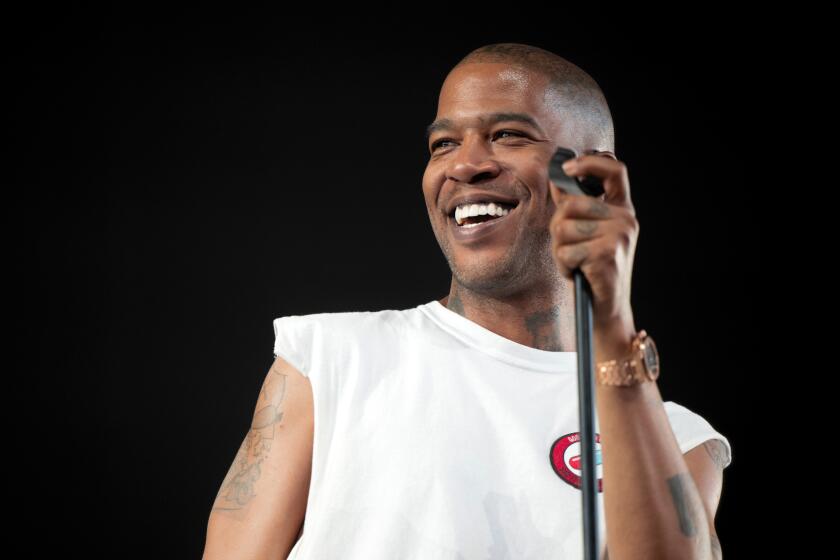Hip-hop strips down, gets intimate
Over three decades, perhaps the only thing that has remained constant in hip-hop is change. The music’s always-evolving sound has spanned break-beats to rock guitar riffs, sinuous gangster funk to the grinding Eurodisco soundscapes of crunk and riffed on just about every other musical form along the way.
These days, hip-hop’s newest dictum seems to be less is more.
A spate of recent recordings arranged over minimalist beats and reliant upon “homemade” sound effects such as whispering, snapping, whistling and slamming doors has quietly ascended the charts.
Sometimes called “intimate club” music, the burgeoning subgenre has become one of the hottest styles in hip-hop.
“The whole stripped-down thing is a really new vibe,” said Jeff Chang, author of “Can’t Stop Won’t Stop: A History of the Hip-hop Generation.” “Very spare. It’s all about pulling sounds out rather than putting them in.”
Hip-hop doesn’t get much simpler than “There It Go (the Whistle Song),” a skeletal yet infectious single by Harlem, N.Y., hard-core rapper Juelz Santana. The song’s most distinctive element is its vaguely sinister wolf whistle chorus, a sample that is repeated three times in descending octaves.
Released last month and currently No. 30 on Billboard magazine’s Hot 100 chart, “Whistle Song” has been featured as a suggested download in magazines such as Spin, Entertainment Weekly and Blender. The rapper described it as his “biggest song ever.”
“Hip-hop fans like something that can be catchy and on-point,” Santana said. “I decided to simplify a little bit more. I knew that the whistle would be something that people could come back to -- and be distinctive. People don’t want to hear too much.”
The chart progress of “Laffy Taffy” seems to bear such wisdom out. At the musical core of the Atlanta rap quartet D4L’s hypnotic single -- a ribald appreciation of the female physique/ode to drugstore candy -- a trio of crude synthesizer notes interplays with drum machine beats and a finger snap sample. The song came out in September and peaked this month at No. 23 on the Hot 100.
“That’s a big street hit,” said Chang.
Characterizing the song’s musical component, he added, “There’s almost nothing going on.”
Atlanta native Michael “Mr. Collipark” Croom is the producer behind two of the most memorable singles of the year: the Ying Yang Twins’ “Wait (the Whisper Song)” and David Banner’s “Play.” Both rely on bare-bones drumbeats, finger snaps and, respectively, whispered and softly rapped vocals.
“Wait” reached No. 5 on the Top 40 Radio Hits chart and No. 3 on the Urban Chart. According to Nielsen SoundScan, “Play” has been downloaded more than 110,000 times since its release last summer and is No. 17 on the Hot 100.
The producer says he became inspired to create a kind of antidote to crunk -- an aggressive hip-hop subgenre with a synth-heavy sound that draws equally upon Miami “Bass” music and firetruck sirens -- that is also the preferred style of platinum-selling producer Lil Jon.
“After Jon came with all those synthesizers, where are you going to go?” Croom said. “You can’t outcrank crunk.”
Late last year, Croom toyed with the idea of recording an entirely whispered rap song. He enlisted his frequent collaborators, Atlanta rappers the Ying Yang Twins, who wanted to record a song for an underground mix-tape.
Whispering aside, the producer aimed to push the rap envelope in another way.
“I wanted women to react to my up-tempo music in the same way they respond to a ballad,” said Croom. “Like ‘Sexual Healing’ from Marvin Gaye? When that comes on, it makes women feel sexy. There hadn’t been an up-tempo rap record that made women feel that way.”
In December, before the mix-tape’s release, the song -- an anatomically specific declaration of sexual intent -- was leaked, and began to get unsanctioned play at nightclubs. By its official February release, “Wait” had become an underground smash.
One of the first artists to request a follow-up “Whisper” song was Mississippi rapper David Banner. During the studio sessions for his single, “Play,” Croom decided to “brand” the production style “intimate club.”
“You have the whole whisper tone and rapping over minimal beats and then you have talking to women,” he said. “They just went together. That’s just how intimate it is.”
While songs such as LL Cool J’s “I Need a Beat” or “The Show/La Di Da Di” by Doug E. Fresh and the Get Fresh Crew are touchstones of early stripped-down hip-hop, Pharrell Williams of the producing duo, the Neptunes, is widely credited with innovating the modern style.
Williams shifted hip-hop’s paradigm with his production on the 2002 hustlers’ anthem, “Grindin’,” for Virginia rap duo Clipse. Beat-wise, the song consists of little more than a metronome-like drum kick and the recurring sample of a door slamming, punctuated by a sonar sound-alike refrain.
That song became a top 50 hit in 2003 and Williams returned to its boilerplate for his 2004 duet with Snoop Dogg, “Drop It Like It’s Hot.”
Relying on similarly homemade sounds, that song’s primary source of percussion isn’t even a drum pattern: Williams and Snoop rap over the tongue-clucking noise that sounds a bit like horse hoofs on concrete. The song held the top spot on the pop singles chart for three weeks.
Croom, who is in the studio recording another intimate club song called “Flatline (Put That On Ya)” with the rapper Homebwoi, is the first to acknowledge Williams’ impact on his work.
“I told Pharrell this: Pharrell influenced me on the ‘Whisper’ record,” he said. “He was the first one to start stripping down beats like that.”
Hip-hop historian Chang sees rap minimalism as a cheap and cheerful response to prohibitive sampling laws that have made it almost impossible for most producers to buy snippets of preexisting music.
He also thinks the cultural embrace of a pared-down sound is in keeping with hip-hop’s evolutionary nature.
“Everyone’s got to have the next thing, the hot thing, and now it’s about a minimal, raw drum sound,” Chang said. “It’s about how the rhythms pull against one another. It’s the generation after crunk.”
More to Read
The biggest entertainment stories
Get our big stories about Hollywood, film, television, music, arts, culture and more right in your inbox as soon as they publish.
You may occasionally receive promotional content from the Los Angeles Times.







